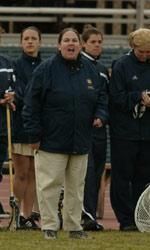Oct. 1, 2004
by Elizabeth Goers
Notre Dame will be represented on both the sidelines and the field this coming summer in the Women’s Lacrosse World Cup to be held at the United States Naval Academy in Annapolis, Md.
Irish Head Coach Tracy Coyne will call the shots for the Canadian National Team, while Notre Dame junior attack standout Crysti Foote will see action on the field.
Coyne has served as Canada’s head coach since 1999 and led them to the medal round in the 2001 World Cup. Funny enough, Coyne herself has no Canadian heritage.
“I went to Perth [Australia] for the Under 19 World Cup in 1999, because we had a player, Kelly McCardell, playing on the US team. At that time, I became aware of the fact that the Canadians were looking for a coach for their senior team,” says Coyne.
“Our athletic director at the time was Mike Wadsworth and he’s Canadian. He really encouraged me to pursue it. So I put my name in and I got the job. I coached the team in 2001 and then I stayed on for this next World Cup.”
At first there was a time of adjustment for Coyne who is in her 18th year coaching women’s lacrosse and her ninth at Notre Dame. She had to get used to a different culture, structure and a whole new set of players.
“It was hard in the beginning, because I’m American,” says Coyne.
“My understanding of the Canadian system was a little bit of a struggle at first, back in ’99 when I took over the team. We were really crunched for time to get ready for the 2001 World Cup.”
Foote, a Canadian citizen, but a resident alien of the United States, joined the team in the summer of 2002. She moved to New York State in sixth grade. She learned how to play box lacrosse with boys and had an adjustment period when she started playing against girls in the states. She got noticed during tryouts for an Under 19 Canadian team and she also knew Coyne from Notre Dame.
“My dad heard about the U-19 Canadian team and my sister (Julie, a Notre Dame freshman) and I went up to Canada from New York and tried out,” says Foote.
“We actually made it, but didn’t end up playing because it was too much of a time commitment. The coach of the U-19’s talked to Tracy and since I knew her from here, I kind of lucked out.”
The Canadian team has eight to ten returning players from the 2001 World Cup campaign. With the addition of a few other key players, Coyne feels that the team is further ahead in their quest for a medal than in the past.
“We have added players of Crysti’s caliber and some other younger college level players,” says Coyne, the only coach in the nine-year history of Notre Dame’s program.
“I think the overall level of talent on the team is a lot higher, but I think that cause we have a core nucleus that has stayed the same, it has made the transition easier. There’s really good camaraderie on the team.”
The Canadian team lost to the host team, England, in the medal round in 2001. Since then the team has done a lot of training and played in test matches versus various teams. In 2003, the team played Wales and this past summer they played three matches versus the U.S. team which helped Coyne determine her team’s strengths and weaknesses.
“The games were a good indication about what we need to work on for the World Cup,” says Coyne.
“We gained confidence from keeping the US close a couple of the halves. It helped us learn how to compete and what we need to do.”
Foote, who has 53 goals and 20 assists for 73 points in two seasons at Notre Dame, did not play against the US because of inflammation of a stress fracture. She is now fully recovered and practicing with Irish and Canada.
The United States team is presently the number one team in the world. This is because of the highly developed high school and college feeder system of the US.
“People really don’t understand how it is, because the national team in the US is so intense and practices all the time, but in Canada women’s lacrosse is very different, it’s not like the college level here,” explains Foote.
“Half of them don’t play every day. They try to on their own, but it’s not as intense. It is different in that aspect. I think that’s what makes it so special, they can come out and try their hardest when they have the chance. That’s why they respect Tracy so much, they have someone to listen to and learn from.”
Women’s lacrosse in Canada is growing in popularity, but is nowhere near a national sport and lacks public attention. Foote described the scene as “expanding, but not really well known.” Men’s lacrosse, however, is popular in Canada, especially box lacrosse which many hockey players participate in during their off-season from. Coyne feels that her experience in the international game and collegiate level will pay off for the Canadians next summer.
“My understanding of the international game is better, and I think I understand our competition better,” says Coyne.
“I think the team has benefited from the fact I am a US college coach. I have a lot of connections so I can get the Canadians into tournaments and different things like that. If they were coached by a Canadian they probably wouldn’t have that same advantage.”
The team had training camp in August and will be heading to George Mason in October. Coyne is planning a longer training camp after Christmas too.
In February of 2003, the Canadians faced Notre Dame in a scrimmage. Coyne has not made her next February schedule yet, but she is not ruling out having her Irish team play her Canadian team.
“Notre Dame is good competition for Canada,” says Coyne.
“Canada hasn’t come close yet. I feel if Canada can get to the stage where they can compete against Notre Dame or some of the other top level division ones then they will be more successful at the international level.”
Some of the team’s training has taken place in Canada and at Notre Dame. It has mainly been on weekends up until this year with most of the tournaments located on the East Coast. Many of the women go to college or work full time jobs so training is sometimes limited.
For Foote, being on both teams has been “pretty easy so far”, because Coyne schedules the Canadian practices and tournaments around the Notre Dame schedule.
Canada’s team also features players from Ohio University, Harvard, Brown, James Madison and Jen Johnson, an assistant coach from the University of Connecticut. Because of the amount of involvement of her team in the college ranks, Coyne refrains from regular practices during the busy part of the college lacrosse season. No other country boasts any Notre Dame players or coaches on their roster.
Both Coyne and Foote have high hopes for the World Cup. Coyne believes the combination of the older players who have never received a medal and the younger players who won one at the Under 19 World Cup leads to a strong desire for a medal.
“We want a medal. I don’t think any of us will be satisfied if we don’t get one,” says Coyne.
“I think we are going to be good and I like the people we work with. They are just fun to be around.”
Training for the World Cup is of a completely different mentality. The team trains years for one week of games and everything is resting on that, instead of a season full of games. Foote, however, has no fear of that one week.
“I am just looking forward to playing and being a part of it,” says Foote.
“I am so excited.”
Coyne has gained a lot from her five years of coaching Canada and has learned a lot about lacrosse on the international level.
“For me the opportunity to work on the international level has been such a rewarding experience, especially working with a different country,” says Coyne.
“There’s the understanding of a different culture and working with women that are older. It’s such a positive experience for me. To work with a different country and in the World Cup has really been a privilege.”








